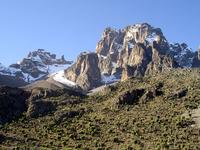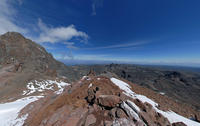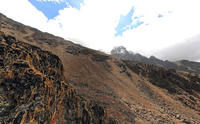You are in: Africa -> Kenya -> Mount Kenya National... , and traditional search or Image Gallery will yield results of this site only
Mount Kenya National Park/Natural Forest
| Site number: | 800 |
|
| Type of site: | Natural | |
| Date: | - | |
| Date of Inscription: | 1997 | |
| Location: | Africa, Kenya, Districts of Meru, Nyeri, Kirnyaga and Embu in Eastern and Central Provinces | |
Up to 75 images are shown here. Click on each for more details or on Image Gallery for more images.
| Description: | The second highest peak in Africa, Mount Kenya reaches 5,199 m in height. It is believed to have risen to 6,500 m during its period of activity 3.1–2.6 million years ago; at present the mountain stands as evidence of an ancient and extinct volcano. Resting on the mountain are 12 remnant glaciers, all of which are diminishing rapidly; sitting at the head of the U-shaped glacial valleys are four secondary peaks. Mount Kenya, endowed with its jagged glacier-clad hilltops and forested middle slopes, is among the most striking landscapes in East Africa. Furthermore, the fruition and ecology of the site’s rich afro-alpine flora offer a stupendous example of ecological processes. --WHMNet paraphrase from the description at WHC Site, where additional information is available. | |
| Mount Kenya National Park ( 0°07′26″S, 37°20′12″E), established in 1949, protects the region surrounding Mount Kenya, the second highest mountain in Africa. 1,300 km² of the park is a forest reserve with 715 km² above the 3000m (10,500ft) tree line. The park was designated a World Heritage Site in 1997. The Government of Kenya had four reasons for creating a national park on and around Mount Kenya. These were the importance of tourism for the local and national economies, to preserve an area of great scenic beauty, to conserve the biodiversity within the park, and to preserve the water catchment for the surrounding area. At lower altitudes Colobus and other monkeys and Cape Buffalo are prevalent. Some larger mammals such as elephants range up to 4,500 m (15,000ft). A small portion of this park's borders near heavy populations have electrified fences to keep the elephants out of the surrounding farmland. Volcanic sediment in the surrounding region's soil and the huge volume of fresh water coming down the slopes makes the area particularly favourable for agriculture. --Wikipedia. Text is available under the Creative Commons Attribution-ShareAlike License. | ||
| Source: | http://whc.unesco.org/en/list/800 | |
| Source2: | http://whc.unesco.org/en/list/800/video | |
| Reference: | 1. UNESCO World Heritage Center, Site Page. | |
































































